MIRACLE data analysis tools
5) Combined
analysis of ground magnetic and ionospheric electric field data using
the
method of characteristics ("JEQ-based" method of characteristics):
- Short description of the
analysis
method:
The "JEQ-based" method of
characteristics
in an spatial inversion method of ground-based data of the magnetic
field
disturbance and the ionospheric electric field, to obtain distributions
of ionospheric conductances and currents. In contrast to the previously
used "trial and error" modeling (i.e., guesses of the desired
ionospheric
quantities are gradually improved until the measured quantities
calculated
from these models fit the real measurements to a given degree of
error),
this method is a forward one, i.e., the desired quantities are
calculated
by solving a differential equation whose coefficients are determined by
the measurements. The primary output of the method is the Hall
conductance,
from which together with the inputs, the ionospheric currents and
field-aligned
currents (FACs) can be calculated. While other methods ("trial and
error",
KRM, AMIE) need guesses or statistical inputs for both Hall and
Pedersen
conductances separately, the method of charactistics only needs an
estimate
of the Hall to Pedersen conductance ratio. This can be assessed from
the
level of ground magnetic disturbance, supported by all-sky camera or
satellite
data if available.
For more details: see
Literature
(below)
- Input data requirements:
Since the method provides spatial
output
distributions, also spatial input data of the ground magnetic and
ionospheric
electric field is required. This means:
-
The method can only be
performed in
the area where both input data sets exist, i.e., northern Fennoscandia
(see MIRACLE map).
-
Good backscatter from both
STARE radars
must be available to obtain electric field vectors for all or most of
the
common field of view of the radar; this is of particular importance in
the southern part of the STARE common field of view, where the
magnetometers
are located (most restrictive requirement)
-
All IMAGE stations must be
available
(typically 3-6 months after the event).
Furthermore, for small analysis
areas
like it is the case here, the uniqueness of the results will depend on
the electric field structure (coarse rule: the more divergences of E
are in the analysis area, the better).
- Output quantities:
Spatial distributions of
ionospheric
conductances, currents and field-aligned currents.
- Literature:
-
Amm, O., Direct determination
of the
local ionospheric Hall conductance distribution from two- dimensional
electric
and magnetic field data: Application of the method using models of
typical
ionospheric electrodynamic situations, J. Geophys. Res., 100,
24173,
1995.
-
Amm, O., Method of
characteristics
in spherical geometry applied to a Harang discontinuity situation, Ann.
Geophys., 16, 413, 1998.
-
Amm, O., P. Janhunen, H.J.
Opgenoorth,
T.I. Pulkkinen, and A. Viljanen, Ionospheric shear flow situations
observed
by the MIRACLE network, and the concept of Harang Discontinuity,
submitted
to AGU monograph on Magnetospheric Current Systems, Geophysical
Monograph 118, 227, 2000.
-
Inhester, B., J.
Untiedt, M.
Segatz, and M. Kürschner, Direct determination of the local
ionospheric
Hall conductance distribution from two-dimensional electric and
magnetic
field data, J. Geophys. Res., 97, 4073, 1992.
- Example plots:
This is the input
data: STARE electric field (thin vectors)
and IMAGE by 90 degrees clockwise rotated ground magnetic field
disturbance
vectors (thick vectors). The event is a shear flow situation observed
on
August 27, 1998, 2330 UT.
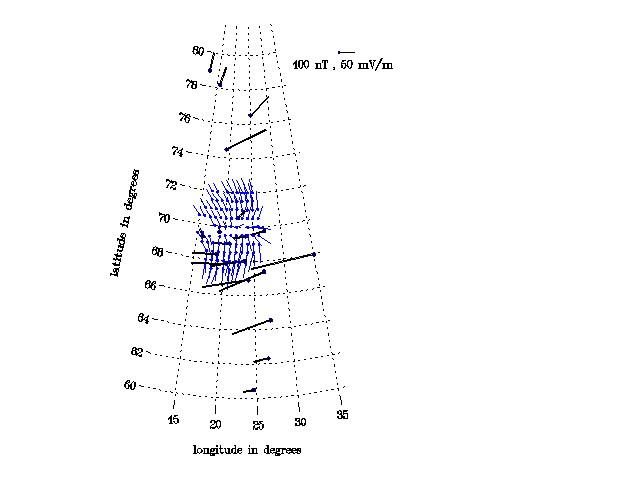
Hall conductance distribution
obtained by the method of characteristics:
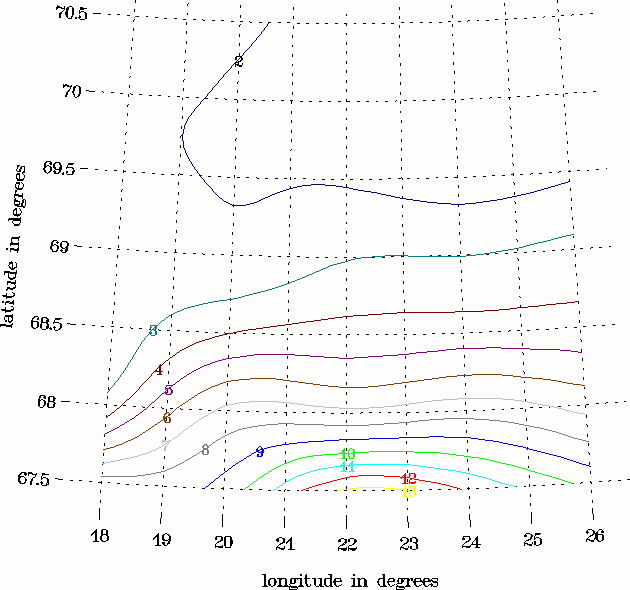
Actual (not equivalent) horizontal
ionospheric currents:
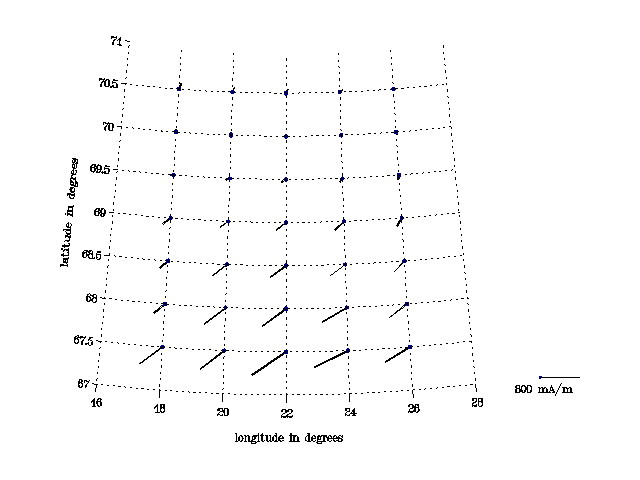
Total field-aligned
currents (FAC):
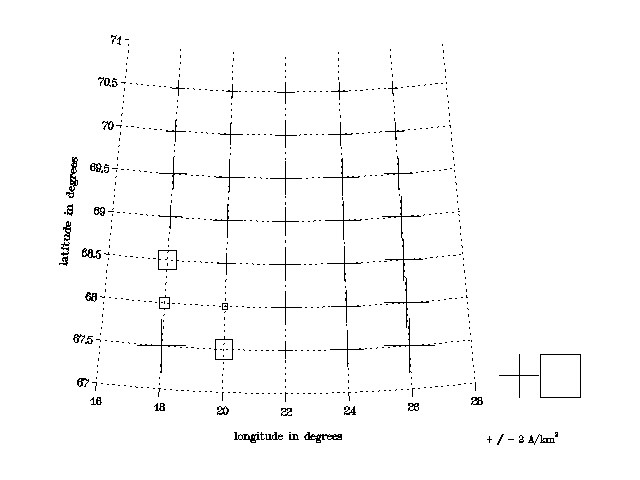
With the results, much of
detailed
analysis can be done, as suitable for the respective study. Among
others,
Hall and Pedersen currents, FACs associated with them, curl-free and
divergence-free
parts of current systems, etc. can be calculated. The example below
shows
the FACs due to Sigma_P * div E
for the situation as above:
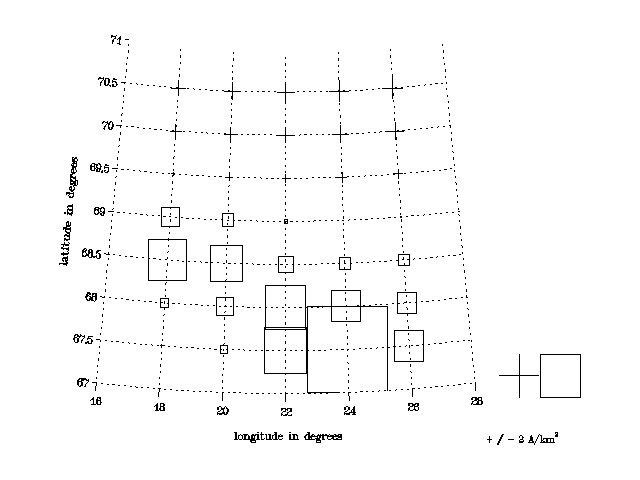
And here are the FACs
due to (grad Sigma_P) * E:
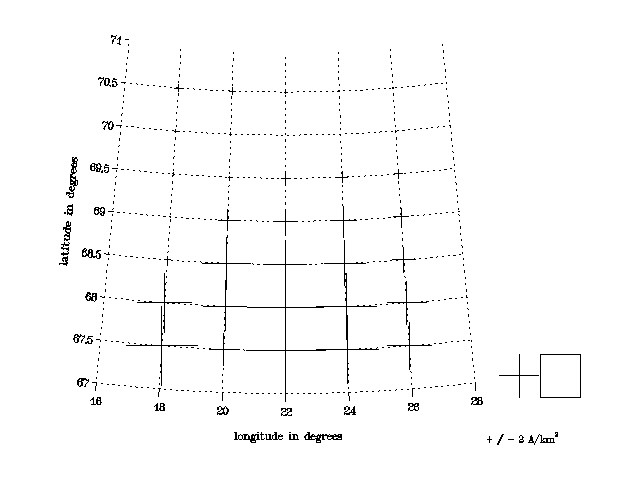
For further questions and
proposals
of events to be analysed, contact Olaf
Amm.
Maintained by: Olaf
Amm
Latest update: 10. 5. 1999






